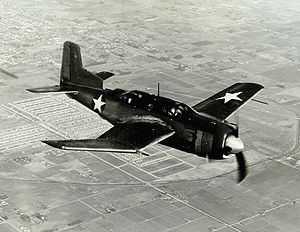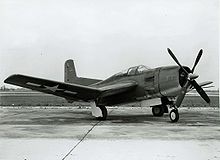Douglas BTD Destroyer Video - Picture

|
|
Douglas BTD Destroyer
BTD Destroyer

Picture - The XSB2D-1 in 1943
Role: Torpedo/dive bomber
Manufacturer: Douglas Aircraft Corporation
First flight: 8 April 1943
Introduced: 1944
Retired: 1945
Primary user: United States Navy
Number built: 30
The Douglas BTD Destroyer was an American torpedo bomber developed for the United States Navy during World War II. It was the first Navy aircraft to have tricycle landing gear.
Development
On June 20, 1941, the United States Navy placed an order with the Douglas Aircraft Company for two prototypes of a new two seat dive bomber to replace both the SBD Dauntless and the new SB2C Helldiver, designated XSB2D-1. The resulting aircraft, designed by a team led by Ed Heinemann, was a large single-engined mid-winged monoplane. It had a laminar flow gull-wing, and unusually for a carrier based aircraft of the time, a Tricycle undercarriage. It was fitted with a bomb-bay and under-wing racks for up to 4,200 lb (1,900 kg), while defensive armament consisted of two wing mounted 20 mm (0.79 in) cannon and two remote controlled turrets, each with two .50 in (12.7 mm) machine guns.
The prototype first flew on April 8, 1943, demonstrating excellent performance, being much faster and carrying nearly double the bombload of the Helldiver, and orders for 358 SB2D-1s quickly followed. The US Navy changed its requirements, however, wanting single seat carrier based torpedo/dive bombers without defensive turrets, and Douglas re-worked the S2BD by removing the turrets and second crewman, while adding more fuel and armour, producing the BTD-1 Destroyer. The orders for S2BDs were converted to BTD-1s, with the first BTD flying on March 5, 1944.
Operational history
The first production BTD-1s were completed in June 1944. By the time Japan surrendered in August 1945, only 28 aircraft had been delivered, and production was cancelled, with aircraft that had been designed from the start as single seaters, such as the Martin Mauler. None saw combat action. In any event, Heinemann and his team were already working on developing the single seat BT2D that became the A-1 Skyraider.
Variants

Picture - The single-seat BTD-1.
XSB2D-1 Prototype two seat torpedo/dive bomber. Two built. SB2D-1 Proposed production version of XSB2D-1. 358 ordered, but order converted to BTD-1 before any completed BTD-1 Single seat variant. 26 built. XBTD-2 Prototypes with mixed propulsion, the additional Westinghouse 19B turbojet in rear fuselage giving 1,500 lbf (6.7 kN) thrust did not sufficiently improve performance. First flight May 1944. Two built.
Operators
United States
United States Navy
Survivor
BTD-1, BuNo 4959, Wings of Eagles Discovery Center, Elmira-Corning Regional Airport, Elmira, New York This aircraft had long been in the Florence Air & Missile Museum collection until the museum's closing in 1997.
Specifications (BTD-1)
Data from Dave's Warbirds
General characteristics
Crew: One
Length: 38 ft 7 in (11.76 m)
Wingspan: 45 ft 0 in (13.72 m)
Height: 13 ft 7 in (4.14 m)
Empty weight: 11,561 lb (5,244 kg)
Max takeoff weight: 19,000 lb (8,618 kg)
Powerplant: 1x— Wright R-3350-14 Cyclone 18 radial engine, 2,300 hp (1,715 kW)
Performance
Maximum speed: 334 mph (290 kn, 538 km/h) at 16,100 ft (4,900 m)
Service ceiling: 23,600 ft (7,195 m)
Armament
2 x— 20 mm (.79 in) cannons
Up to 3,200 lb (1,450 kg) of bombs in the bomb bay or a single torpedo
Comparable aircraft
Blackburn Firebrand
BTM Mauler
Curtiss XSB3C
Bibliography
Dave's Warbirds
Donald, David and Lake, Jon. Encyclopedia of World Military Aircraft. London: AIRtime Publishing, 1996. ISBN 1-88058-824-2.
Francillon, René J. McDonnell Douglas Aircraft since 1920. London:Putnam, 1979. ISBN 0-370-00050-1.
Kowalski, Bob and Ginter, Steve. Douglas XSB2D-1 & BTD-1 Destroyer. Simi Valley:Ginter, 1995. ISBN 0-942612-30-2
Douglas BTD Destroyer Pictures
More aircraft.
Source: WikiPedia